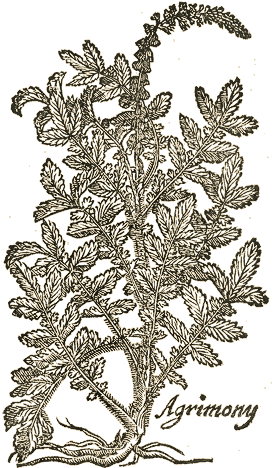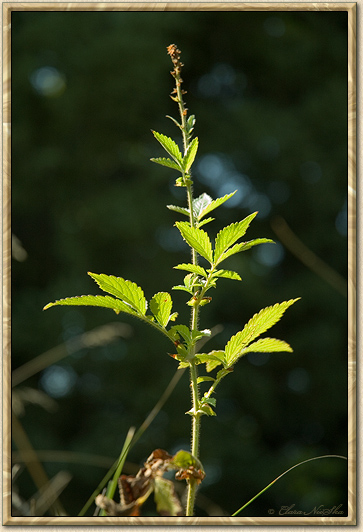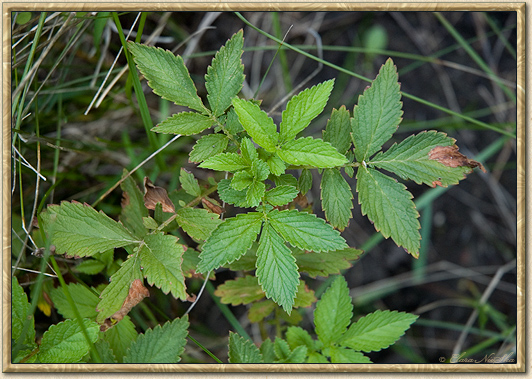|
|
IV. The Indispensable Relaxant.
We always need a remedy to relax tension and remove ‘wind’ or constriction and in this agrimony is inferior to none. Intensify by combining 7 parts agrimony to 4 parts Solomon’s seal. Works well with the nervines.
Agrimonia eupatoria, A. grysopetela.
Agrimony.
Agrimony is a member of the rose family native to temperate regions of the globe. It has a history of moderate use in Europe, China, and North America. It has properties similar to its close cousin cinquefoil (Potentilla spp.). The latter was generally more popular in folk medicine due to the resemblance the five leaves have to the fingers. Both Agrimonia and Potentilla are astringents which improve tissue tone, but they have also been used to relieve tension – both were used for the tense intermittent chills of malaria back to the time of Dioscorides. They can be used fairly interchangeably. It is in tension that their properties manifest most completely. Agrimony contains tannins, flavonoids, coumarins, polysaccharides, small amounts of glycosidal bitters, and minerals (including silicon). The American species can be substitued for the European – I think it is a little more sweet and aromatic than the European.
|
 |
 |
“Agrimony is a simple well known to all country folk, and abundant through England in the fields and woods, as a popular domestic medicinal herb,” writes W. T. Fernie (1919, 18). “Its use in the cottage for gargles, and as an astringent application to indolent wounds, is well justified.” It is best known as a specific for diarrhea and bedwetting, applications that carry over into modern British herbalism. However, this ancient simple is for so much more than this. It is, as Pliny says, an herb of “princely authoritie.”
Agrimony is a superlative remedy for tension. This indication, originated by Dr. Edward Bach, holds true on both the mental and physical levels, for both the flower essence and the herbal preparation. It is for the person who tries to hide his or her tension behind a false facade of suave sophistication or cheerfulness. He denies the pain with a smile. The phrase ‘torturedly cheerful’ is expressive of the appearance. In other instances, agrimony people like speed and danger to excape from their pain(Bach). Such activities push the agrimony person into an excess sympathetic condition which masks the deeper pain and gets them stuck there. Bach also says there can be abuse of drugs, alcohol, and stimulants to excape the pain. The problem often revolves around business and hierarchical relations (employee/employer). The person feels ‘caught in a bind.’
Agrimony is a specific in any condition where the person holds the breath to stop the pain. This causes the release of endorphins – the body’s own opiates – which suppress pain. Agrimony people need to learn to ‘breath through’ the pain. As a consequence, the respiratory apparatus is affected. Agrimony is suited to conditions where the person is ‘tortured to capture the breath,’ as Dr. Bach noted. “Agrimonia exerts a specific influence upon mucous membranes, checking profuse secretion and favoring normal activity. This action has suggested its usefulness in chronic bronchitis and in phthisis” (John William Fyfe, 1909, 355). Samuel Henry (1814, 12) treats us to a case history. “I knew a man at Flat brook, near Sussex [New Jersey]. who informed me that he had spent near three hundred pounds with Dr. Kanady, without receiving any benefit; but by drinking the decoction of agrimony root. . . was perfectly cured of his asthmatic complaint.” Dr. J. V. Cerney (1976) also used agrimony root for bronchitis. He mentions a child with unstoppable coughing, night and day, until he turned blue. Cured with agrimony root. I have several times used agrimony leaf with success for bronchitis and asthma, or for conditions elsewhere in the body which cause the person to hold the breath to stop the pain.
One would think that as an astringent agrimony was purely for relaxation, and hence for diarrhea and excessive urination, as it has been traditionally used. However, David Hoffmann provides the context. For example, agrimony is suited to problems when they arise in children who are having trouble with toilet training. So there is tension combined with symptoms of relaxation.
As an astringent, agrimony has been used for all sorts of digestive problems, but it is suited to those where tension and relaxation combine to cause incorrect timing of functions. This element of the picture is developed by Dorothy Hall (1987, 78). It is suited to diarrhea, as are all astringents, but especially to cases where there are loose, floating stools with fats in them due to irregular or deficient discharges of bile and poor digestion of fats and oils. Acting further back up into the hepatic apparatus, it is good for hepatitis and cirrhosis from chronic alcoholism or food poisoning, with faulty fat metabolism, and irregular expulsion of bile. There may be ulceration of the bowels, blood in the stool and bloody hemorrhoids.
Circulation to the liver, gallbladder and gastrointestinal are off so that the hepatic cells do not receive the correct amount of ‘live giving’ arterial blood when they receive the dose of toxin ladden blood from the portal vein and the intestines – at least, this is my picture of the situation. Consequently, there are liver problems, allergies, skin rashes and wasting (due to poor liver anabolism and catabolism of proteins and fats). Scudder notes that there is cirrhosis beginning in the lower parts of the liver, where the input of blood from the hepatic artery is less direct. Tension and suppressed anger are emotions associated with the liver and gallbladder, East and West.
Agrimony acts strongly on the kidneys, a situation Dorothy Hall attributes to the presence of silica in the plant. The leaves “are found by experience to be good in the diabetes and incontinence of urine” (John Hill, 1740, 55). Peter Smith, an “Indian doctor” in Ohio, considered it indicated for incontinence following the passage of stones. Dr. John Scudder writes, “Given a pain in the region of the kidneys, and I always think of agrimonia as the remedy. In my practice I have seen wonderful results from it, in cases of months’ and years’ duration, and when everything had failed. I have found other uses for it, but this has been so prominent that I always associate the medicine and the position of the pain.” He considered it specific in “pointing pains” in the kidneys, from any cause.
“Among neuralgias, nephralgia is one of the severest. It is torture that might be borne for an hour or a day; but continued night and day for a fortnight or a month, the sufferer may well pray fro relief or death. It varies in cause, in some a well-defined lithemia [stones], in others there is absolutely nothing to be determined wrong with the urine.”
“It is one of those singular remedies that follow the specific indications sharply; and the indication is, pain in the region of the kidneys, especially of the right side” (Scudder, quoted by Fyfe, 1909, 355-56).
Agrimony helps relieve the pain accompanying passage of gravel. Peter Smith (1812) used it for leaky bladder following the passage of kidney stones – here we see perfectly the idea of an astringent used for problems caused by tension. John Wesley (1791) recommended agrimony tea at breakfast for three months to prevent the return of kidney stones.
One of my students found it very unpleasant to pick agrimony because it produced symptoms she called soroche (Spanish for altitude sickness). “You feel really tired, like you want to be lower – like from the bed to the floor. You’re digestion just stops. You get a queazy/nauseous feeling. Gas builds up, but you might get diarrhea.”
Taste: (before flowering): mildly sweet • sour • astringent
(after flowering): increasingly astringent
Tissue State: constriction, relaxation, atrophy

Specific Indications
Mind, Senses, Nerves, Emotions, Personality
– Mental tension; feels caught in a bind, “torturedly cheerful,” hides anger and frustration behind
an artificial facade; suave but inwardly tortured.
– Work-related tension; employer-employee tension.
– Holds the breath to suppress the pain.
– Resorts to drugs, alcohol, speed and danger to suppress emotions; “sex and drugs and
rock ‘n’ roll”(Julia Graves).
– Tense, wiry pulse.
Head
– Tension headaches.
– Slight yellow/gray complexion.
– Allergic welts associated with tension.
– Hardened ear wax (warm infusion in the ear).
– Ulcerations of the tongue, sores in the mouth, aphthae.
Respiration
– Pharyngitis.
– Tonsillitis, relaxed throat (with Salvia).
– Respiratory problems; whooping cough, bronchitis, asthma; “tortured to capture the breath;”
holds the breath.
– Catarrhal flow.
Digestion
– Low appetite.
– Ulceration of the gastrointestinal tract; tongue, mouth, stomach, intestines.
– Difficulty with fat digestion and metabolism.
– Nausea, vomiting, diarrhea with griping and spasms; belly ache from spasms anywhere,
especially guts.
– Constipation suddenly followed by diarrhea.
– Loose, fatty, floating stools; undigested food, large lumps, nuts, proteins in the stool.
– Food poisoning, amebic dysentery, gastroenteritis; doesn’t kill the microorganisms but tones
the bowels (cf. Rubus).
– Mucus colitis.
– “Appendicitis;” traditionally used in British herbalism for low grade irritation; may actually
be cases of ileo-cecal irritation.
Liver
– Hepatitis, cirrhosis, hepatic atrophy, jaundice.
– Tension and pain during the passage of a gall- or kidney-stone; blue, purple tongue, wiry pulse
and holding of the breath to stop the pain.
Kidneys and Bladder
– Atonic conditions of the urinary apparatus, and where the urine is thick and gelatinous.
– Pointing pains in the kidneys; with or without the passage of stones, in various kinds of urinary problems.
– Urinary tract infections with severe pain.
– Bed-wetting and diarrhea; in children suffering anxiety about toilet training.
– Incontinence in the elderly; after passing stones.
– Edema with welts, coming and going suddenly.
– Acid urine, mild bladder and urethral inflammation; especially with dull pain in the lower back and
flank (tea).
Female
– Menstrual pain, cramps and colic; hides the pain, pretends to be fine, composed.
– Vaginal ulceration.
Muscular and Skeletal
– Articular, spinal pain, acute and chronic; torturous; sprains and strains.
Skin
– Ulceration on the labia, buttocks, legs.
– Skin rash, allergies, ulcers, psoriasis; with mental tension.
– Wounds, bruises, splinters; passive bleeding.
Fever
– Influenza; intermittent chills and fever; with pain in the joints.
Other
– High LDLs and platelet aggregation (tea).
– (?) Altitude sickness.

Preparation and dosage:
It is best to pick the leaves off the sides of the stem, leaving the leader to go into seed, in early summer, before flowering. Harvested after flowering they are less sweet and more astringent (Matthew Wood). An old Southern manuscript notes that a “strong odor” is desirable (Moss, 1999, 169). This is true. Harvest from many different sites to insure full range of properties (Dorothy Hall). Dose of the tincture: 1-15 drops, 1-3x/day (Matthew Wood), or 1-2 drams to 4 ounces of water (Rolla Thomas).
Contra-indications:
None known (German E Commision; Bisset and Wichtl, 2001).
Literature:
Traditional (22, 27, 37), Edward Bach (1, 4, 11, 31), Matthew Wood (1-8, 10, 13, 21, 25, 29-31, 33-37, 39), Julia Graves (1, 3, 4, 6, 16, 18, 30), Samuel Henry (13, 27, 37), John Scudder (21, 27), Finley Ellingwood (10, 16, 24, 28, 33), Michael Moore (32, 40), David Hoffman (29), Jack Ritchason (24), Dorothy Hall (4, 17-9, 21), Rolla Thomas (26), Christopher Menzies-Trull (9, 11, 12, 14, 16), John Hill, (29-30), Dioscorides (39), W. T. Fernie (10, 12, 38), Sarah Duncklee (41). An extensive account is given in Matthew Wood, The Book of Herbal Wisdom.
Selections from The Earthwise Herbal
By Matthew Wood M.Sc. (Herbal Medicine)
Registered Herbalist (AHG)
To be published by North Atlantic Books, in two volumes, 2008-9
"In a busy practice covering over twenty five years and tens of thousands of clients, a person learns what remedies are of invaluable service. I would like to share my selection – herbs I choose and herbs that choose me."
|
|